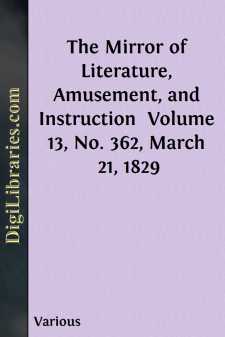Categories
- Antiques & Collectibles 13
- Architecture 36
- Art 48
- Bibles 22
- Biography & Autobiography 813
- Body, Mind & Spirit 142
- Business & Economics 28
- Children's Books 14
- Children's Fiction 11
- Computers 4
- Cooking 94
- Crafts & Hobbies 4
- Drama 346
- Education 46
- Family & Relationships 57
- Fiction 11829
- Games 19
- Gardening 17
- Health & Fitness 34
- History 1377
- House & Home 1
- Humor 147
- Juvenile Fiction 1873
- Juvenile Nonfiction 202
- Language Arts & Disciplines 88
- Law 16
- Literary Collections 686
- Literary Criticism 179
- Mathematics 13
- Medical 41
- Music 40
- Nature 179
- Non-Classifiable 1768
- Performing Arts 7
- Periodicals 1453
- Philosophy 64
- Photography 2
- Poetry 896
- Political Science 203
- Psychology 42
- Reference 154
- Religion 513
- Science 126
- Self-Help 84
- Social Science 81
- Sports & Recreation 34
- Study Aids 3
- Technology & Engineering 59
- Transportation 23
- Travel 463
- True Crime 29
The Mirror of Literature, Amusement, and Instruction Volume 13, No. 362, March 21, 1829
by: Various
Categories:
Description:
Excerpt
CHESTER TERRACE,
REGENT'S PARK.
On the annexed page is a spirited representation of this splendid range of palatial residences, which present as noble an appearance as any similar structure in the Park.
To familiarize the topography of Chester Terrace, we should say it stands between the Colosseum and St. Katharine's Church, these being the most conspicuous buildings in the circle; and the majestic cupola of the former building is shown in the distance of our engraving.
This terrace is named from the royal earldom of Chester. It is from the designs of Mr. Nash, the architect of York Terrace engraved in our No. 358. Like the majority of that gentleman's works, Chester Terrace evinces great genius, with many of its irregularities. It is of the Corinthian order of architecture, characterized by its richness; but the present specimen is weak in its details, and the form and proportions of its balustrade are starved and lanky. The capitals of the columns want the gracefulness of the Corinthian, and the volutes are but puny illustrations of that beautiful order.
Leaving these defects to be further scrutinized by the more critical spectator, we cannot fail to be impressed with this grand and commanding terrace; the composition exhibits great genius and powerful conception; and the effect of the whole would be extremely beautiful, were it not for the defective details.
At each end of the terrace is a Corinthian arch, the idea of which is altogether novel. These arches connect with pavilion temple-like mansions, and their effect is very rich and picturesque. They remind one of some of the trophied glories of old Rome—the arches beneath which her laurelled heroes passed in triumphal state. Chester Terrace may, therefore, be said to associate otium cum dignitate, since these arches give a splendid finish to the range of handsome residences. The mementos of Roman triumph still remain; but a century hence, where will be the lath-and-plaster glories of the Regent's Park?
(For the Mirror.)"Haver" is a common word in the northern counties for oats; as "haver bread," for oaten bread; perhaps properly "aven," from "avena," Latin for oats.
Query.—Is not "haversack," or, Gallice, "havre-sac," a bag to carry a soldier's bread and provisions, derived from the same word?
W.T.H.
ANCIENT POWER OF THE HARO, OR HAROL.
(For the Mirror.)Clamour de haro is a cry or formula of invoking the assistance of justice against the violence of some offender, who, upon hearing of the word haro, is obliged to desist, on pain of being severely punished for his outrage, and to go with the party before the judge. The word is commonly derived of ha and roul, as being supposed an invocation of the sovereign power, to assist the weak against the strong, on occasion of Raoul, first duke of Normandy, about the year 912, who rendered himself venerable to his subjects, by the severity of his justice; so that they called on him, even after his death, when they suffered any oppression. Some derive it from Harola, king of Denmark, who, in the year 826, was made grand conservator of justice at Mentz....












